On the Long-Period Accuracy Behavior of Inductive and Low-Power Instrument Transformers
Abstract
:1. Introduction
2. Instrument Transformers
2.1. Introduction and Standards
2.2. Uncertainty Evaluation
2.3. Types of VTs
3. Experimental Measurement Setup
- An Agilent 6813B power source to feed the insulating and the step-up transformers. It features a max rms voltage of 300 V and a max power of 1750 VA.
- An insulating transformer with 1:1 ratio. Its main purpose is to provide galvanic insulation between the low- and the medium-voltage sides.
- A step-up transformer with 1:142 ratio. It guarantees a stable 20/√3 kV voltage at the terminals of the transformers under test.
- A reference capacitive-resistive VT used to measure the rated voltage that has to be used in the accuracy computations. It features a 5981:1 ratio and an accuracy of 0.03% on the ratio and 0.3 mrad on the phase, according to its calibration certificate.
- Three off-the-shelf VTs under test. Two are LPVTs, while the third is a classical inductive VT. Their main characteristics are listed in Table 1. In particular, the type, the primary and the secondary rated voltages ( and ), and the accuracy class (AC) of the VTs are reported.
- A pure-resistive voltage divider, previously characterized, has been used to reduce the secondary voltage of B to a level suitable for the acquisition system. The divider ratio is 100:1 and it is composed of high-precision resistors that can be considered insensitive to temperature variations (few ppm/°C).
- An NI9239 data acquisition board (DAQ) to collect the secondary voltages of the three transformers under test plus the secondary voltage of the reference one. The DAQ features a full scale of ±10 V, a 24-bit architecture, 50 kSa/s per channel of maximum acquisition rate, and gain and offset errors of ±0.03% and ±0.008%, respectively.
- An NCT75 programmable temperature sensor, the characteristics of which are listed in Table 2. The sensor was used to measure the ambient temperature at which the transformers were operating.
4. Experimental Tests and Results
4.1. Experimental Tests
4.2. Experimental Results
4.3. Discussion
- In the considered short temperature range, it is possible to conclude that the accuracy of inductive VTs was not affected by temperature. However, it is not automatically true that this conclusion holds for wider ranges of temperature.
- Over long time intervals, the developed setup allowed even the tiniest variations of ε and Δφ due to very small changes in the ambient temperature to be seen. As a result, such slight temperature variations had a visible effect on the LPVT’s accuracy (even if absolutely moderate). The same could not be stated for the inductive ones.
- The different ways of spreading ε and Δφ values between LPVTs and legacy ITs raises a significant issue: when modelling them, it is not possible to simulate their behavior in the same way, even at rated conditions.
- What was observed for LPVT might be a strength or a drawback of this new generation of transformers. However, what is clear is that, considering their diffusion among distribution networks, such information has to be considered when choosing the technology to be installed in a particular operating environment.
- What was observed at rated conditions and at an ambient temperature that varies not more than a couple of degrees reinforced the studies on the influential quantities affecting the behavior, and hence the accuracy, of all kind of ITs.
- The different behaviors recorded for classical VTs and LPVTs highlight the need to differentiate the modelling of such transformers. Therefore, general models should be particularized for the specific VT that is going to be used in the considered application.
5. Conclusions
Author Contributions
Funding
Conflicts of Interest
References
- Our Vision for a Clean Planet for All. Available online: https://ec.europa.eu/clima/sites/clima/files/docs/pages/vision_1_emissions_en.pdf (accessed on 3 September 2020).
- Aggarwal, A.; Das, N.; Arora, M.; Tripathi, M.M. A novel hybrid architecture for classification of power quality disturbances. Presented at the 2019 6th International Conference on Control, Decision and Information Technologies (CoDIT 2019), Paris, France, 23–26 April 2019; pp. 1829–1834. [Google Scholar]
- Mohammadi, M.; Afrasiabi, M.; Afrasiabi, S.; Parang, B. Detection and classification of multiple power quality disturbances based on temporal deep learning. Presented at the 2019 IEEE International Conference on Environment and Electrical Engineering and 2019 IEEE Industrial and Commercial Power Systems Europe (EEEIC/I and CPS Europe), Genova, Italy, 11–14 June 2019. [Google Scholar]
- Xin, K.; Duan, B.; Qu, X. Classification for multiple power quality disturbances based on deep forest. Presented at the IECON Proceedings (Industrial Electronics Conference), Lisbon, Portugal, 14–17 October 2019; pp. 3387–3392. [Google Scholar]
- Zhao, L.; Gai, M. Identification of multiple power quality disturbances based on the improved s-transform and wavelet transform energy distribution. J. Inf. Hiding Multimed. Signal Process. 2018, 9, 188–197. [Google Scholar]
- Crotti, G.; Giordano, D.; D’Avanzo, G.; Femine, A.D.; Gallo, D.; Landi, C.; Palladini, D. Measurement of dynamic voltage variation effect on instrument transformers for power grid applications. Presented at the I2MTC 2020—International Instrumentation and Measurement Technology Conference, Dubrovnik, Croatia, 25–28 May 2020. [Google Scholar]
- Mingotti, A.; Peretto, L.; Tinarelli, R.; Zhang, J. Use of COMTRADE fault current data to test inductive current transformers. Presented at the 2019 IEEE International Workshop on Metrology for Industry 4.0 and IoT, MetroInd 4.0 and IoT, Naples, Italy, 4–6 June 2019; pp. 103–107. [Google Scholar]
- Seo, H.C.; Kim, C.H. The analysis of power quality effects from the transformer inrush current: A case study of the jeju power system, Korea. Presented at the IEEE Power and Energy Society 2008 General Meeting: Conversion and Delivery of Electrical Energy in the 21st Century (PES), Pittsburgh, PA, USA, 20–24 July 2008. [Google Scholar]
- Draxler, K.; Stybliková, R. Influence of instrument transformers on quality of electrical power and energy measurement. Presented at the IEEE International Symposium on Industrial Electronics, Vigo, Spain, 4–7 June 2007; pp. 1317–1321. [Google Scholar]
- Kezunovic, M.; Portillo, L.; Karady, G.; Kucuksari, S. Impact of optical instrument transformer characteristics on the performance of protective relays and power quality meters. Presented at the 2006 IEEE PES Transmission and Distribution Conference and Exposition: Latin America (TDC’06), Caracas, Venezuela, 15–18 August 2006. [Google Scholar]
- Kaczmarek, M.; Nowicz, R. Application of instrument transformers in power quality assessment. Presented at the International Symposium: Modern Electric Power Systems (MEPS’10), Wroclaw, Poland, 20–22 September 2010. [Google Scholar]
- Bartolomei, L.; Mingotti, A.; Pasini, G.; Peretto, L.; Rinaldi, P.; Tinarelli, R.; Puddu, L. Performance evaluation of an energy meter for low-voltage system monitoring. In Proceedings of the 22nd World Congress of the International Measurement Confederation (IMEKO), Belfast, UK, 3–6 September 2018. [Google Scholar]
- Das, H.; Saikia, L.C. Ethernet based smart energy meter for power quality monitoring and enhancement. Presented at the 2017 Recent Developments in Control, Automation and Power Engineering (RDCAPE 2017), Noida, India, 26–27 October 2017; pp. 187–191. [Google Scholar]
- Palacios-Garcia, E.J.; Rodriguez-Diaz, E.; Anvari-Moghaddam, A.; Savaghebi, M.; Vasquez, J.C.; Guerrero, J.M.; Moreno-Munoz, A. Using smart meters data for energy management operations and power quality monitoring in a microgrid. Presented at the IEEE International Symposium on Industrial Electronics, Edinburgh, UK, 19–21 June 2017; pp. 1725–1731. [Google Scholar]
- Ganev, E. Selecting the best electric machines for electrical power-generation systems: High-performance solutions for aerospace more electric architectures. IEEE Electrif. Mag. 2014, 2, 13–22. [Google Scholar] [CrossRef]
- Masoum, M.A.S.; Fuchs, E.F. Power Quality in Power Systems and Electrical Machines, 2nd ed.; Academic Press: Cambridge, MA, USA, 2015; pp. 1–1123. [Google Scholar]
- Peretto, L.; Tinarelli, R.; Ghaderi, A.; Mingotti, A.; Mazzanti, G.; Valtorta, G.; Danesi, S. Monitoring cable current and laying environment parameters for assessing the aging rate of MV cable joint insulation. Presented at the Annual Report—Conference on Electrical Insulation and Dielectric Phenomena (CEIDP), Cancun, Mexico, 21–24 October 2018; pp. 390–393. [Google Scholar]
- Bhattacharyya, S.; Chakraborty, A.; Saha, B.; Chatterjee, S. Electric stress analysis of a medium voltage cable termination subjected to standard and non-standard lightning impulse voltages. Presented at the 2016 International Conference on Intelligent Control, Power and Instrumentation (ICICPI), Kolkata, India, 21–23 October 2016; pp. 169–173. [Google Scholar]
- Patel, U.; Jayaram, S.H. Impact of poor power quality on stress grading system of cable termination. Presented at the Annual Report—Conference on Electrical Insulation and Dielectric Phenomena (CEIDP), Montreal, QC, Canada, 14–17 October 2012; pp. 463–466. [Google Scholar]
- Mingotti, A.; Peretto, L.; Tinarelli, R. Accuracy evaluation of an equivalent synchronization method for assessing the time reference in power networks. IEEE Trans. Instrum. Meas. 2018, 67, 600–606. [Google Scholar] [CrossRef]
- Murray, R.; De Kock, J. Instrument transformers influence on harmonic measurements for grid code compliance. Presented at the 2018 IEEE 4th Global Electromagnetic Compatibility Conference (GEMCCon), Stellenbosch, South Africa, 7–9 November 2018. [Google Scholar]
- Mingotti, A.; Peretto, L.; Tinarelli, R. An equivalent synchronization for phasor measurements in power networks. Presented at the AMPS 2017—IEEE International Workshop on Applied Measurements for Power Systems, Liverpool, UK, 20–22 September 2017. [Google Scholar]
- Ren, X.; Ding, W.; Zhou, W.; Fan, C.; Wu, J.; Liu, Y.; Zhang, G. The moisture in SF6 insulated CTs considering current and change of ambient temperature. IEEE Trans. Power Deliv. 2014, 29, 1184–1191. [Google Scholar] [CrossRef]
- Yan, Z.; Ren, X.; Ren, H.; Ding, W. Study on condensation of the moisture in current transformers with current flow considering sharp temperature decrease. Appl. Mech. Mater. 2013, 241–244, 322–327. [Google Scholar] [CrossRef]
- Lesniewska, E.E.; Olak, J. Improvement of the insulation system of unconventional combined instrument transformer using 3-d electric-field analysis. IEEE Trans. Power Deliv. 2018, 33, 2582–2589. [Google Scholar] [CrossRef]
- Yan, X.; Sun, Y.; Yu, C.; Xie, D. Electric field analysis and optimal design of main insulation for oil-immersed inverted current transformers. Diangong Jishu Xuebao/Trans. China Electrotech. Soc. 2014, 29, 37–43. [Google Scholar]
- Youhua, G.; Dan, G.; Yanbin, L.; Shuqiu, G.; Guogang, W. Improvement of main insulation structure for 110 kV electric power transformer based on electric field analysis. Presented at the 11th International Conference on Electrical Machines and Systems (ICEMS), Wuhan, China, 17–20 October 2008; pp. 4427–4430. [Google Scholar]
- Li, Z.; Du, Y.; Abu-Siada, A.; Li, Z.; Zhang, T. A new online temperature compensation technique for electronic instrument transformers. IEEE Access 2019, 7, 97614–97623. [Google Scholar] [CrossRef]
- Sivan, V.; Robalino, D.M.; Mahajan, S.M. Measurement of temperature gradients inside a medium voltage current transformer. Presented at the 2007 39th North American Power Symposium (NAPS), Las Cruces, NM, USA, 30 September–2 October 2007; pp. 242–245. [Google Scholar]
- Mingotti, A.; Peretto, L.; Tinarelli, R.; Ghaderi, A. Uncertainty sources analysis of a calibration system for the accuracy vs. temperature verification of voltage transformers. In Proceedings of the 22nd World Congress of the International Measurement Confederation (IMEKO), Belfast, UK, 3–6 September 2018. [Google Scholar]
- IEC 61869-1: 2010. Instrument Transformers—Part 1: General Requirements; International Standardization Organization: Geneva, Switzerland, 2010. [Google Scholar]
- IEC 61869-6:2016. Instrument Transformers—Part 6: Additional General Requirements for Low-Power Instrument Transformers; International Standardization Organization: Geneva, Switzerland, 2016. [Google Scholar]
- IEC 61869-2:2012. Instrument Transformers—Part 2: Additional Requirements for Current Transformers; International Standardization Organization: Geneva, Switzerland, 2012. [Google Scholar]
- IEC 61869-3:2011. Instrument Transformers—Part 3: Additional Requirements for Inductive Voltage Transformers; International Standardization Organization: Geneva, Switzerland, 2011. [Google Scholar]
- IEC 61869-10:2018. Instrument Transformers—Part 10: Additional Requirements for Low-Power Passive Current Transformers; International Standardization Organization: Geneva, Switzerland, 2018. [Google Scholar]
- IEC 61869-11:2018. Instrument Transformers—Part 11: Additional Requirements for Low-Power Passive Voltage Transformers; International Standardization Organization: Geneva, Switzerland, 2018. [Google Scholar]
- BS EN 50160:2010+A1:2015. Voltage Characteristics of Electricity Supplied by Public Electricity Networks; BSI Standards Publication: London, UK.
- IEEE Std. 519-2014. Recommended Practice and Requirements for Harmonic Control in Electric Power Systems; IEEE: New York, NY, USA, 2014. [Google Scholar]
Publisher’s Note: MDPI stays neutral with regard to jurisdictional claims in published maps and institutional affiliations. |
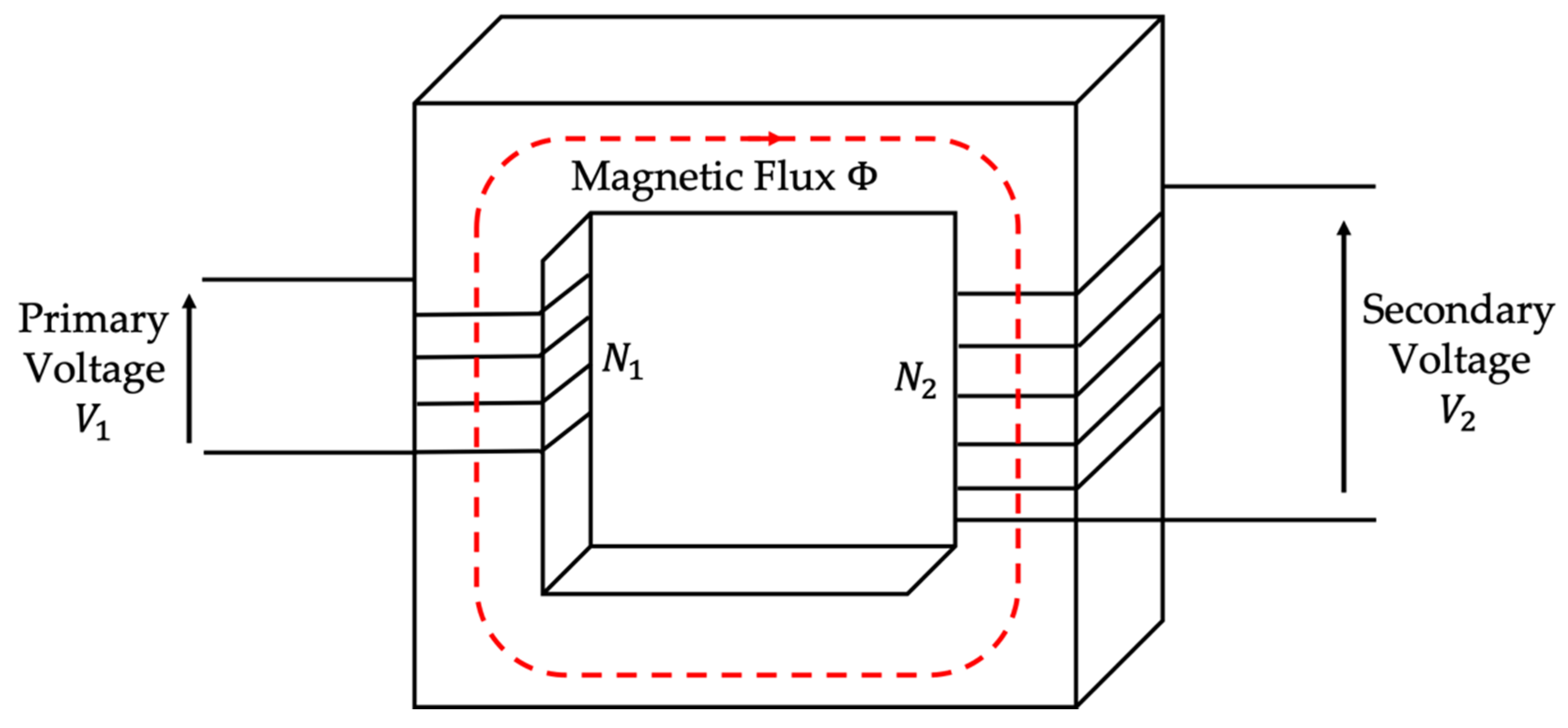

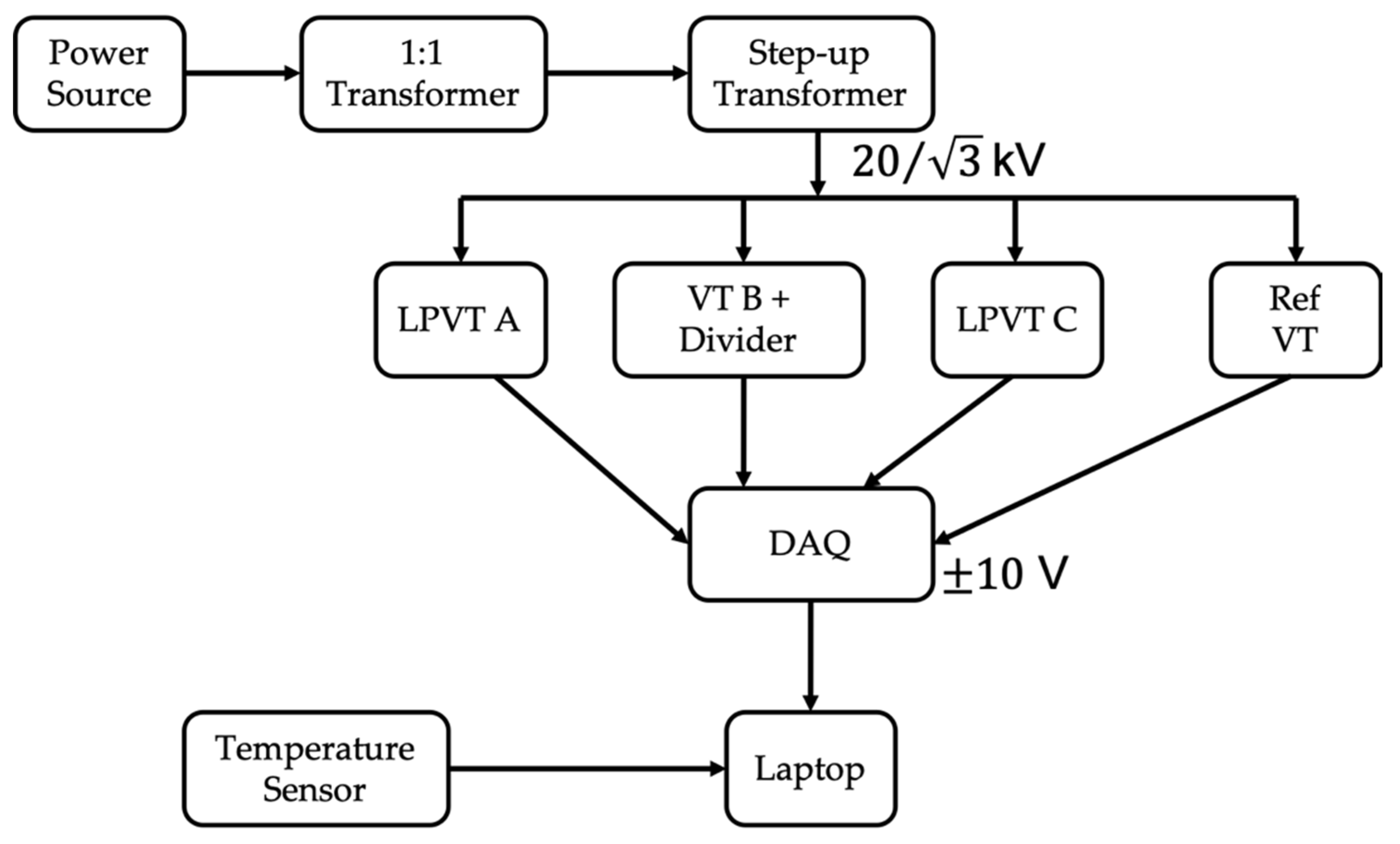
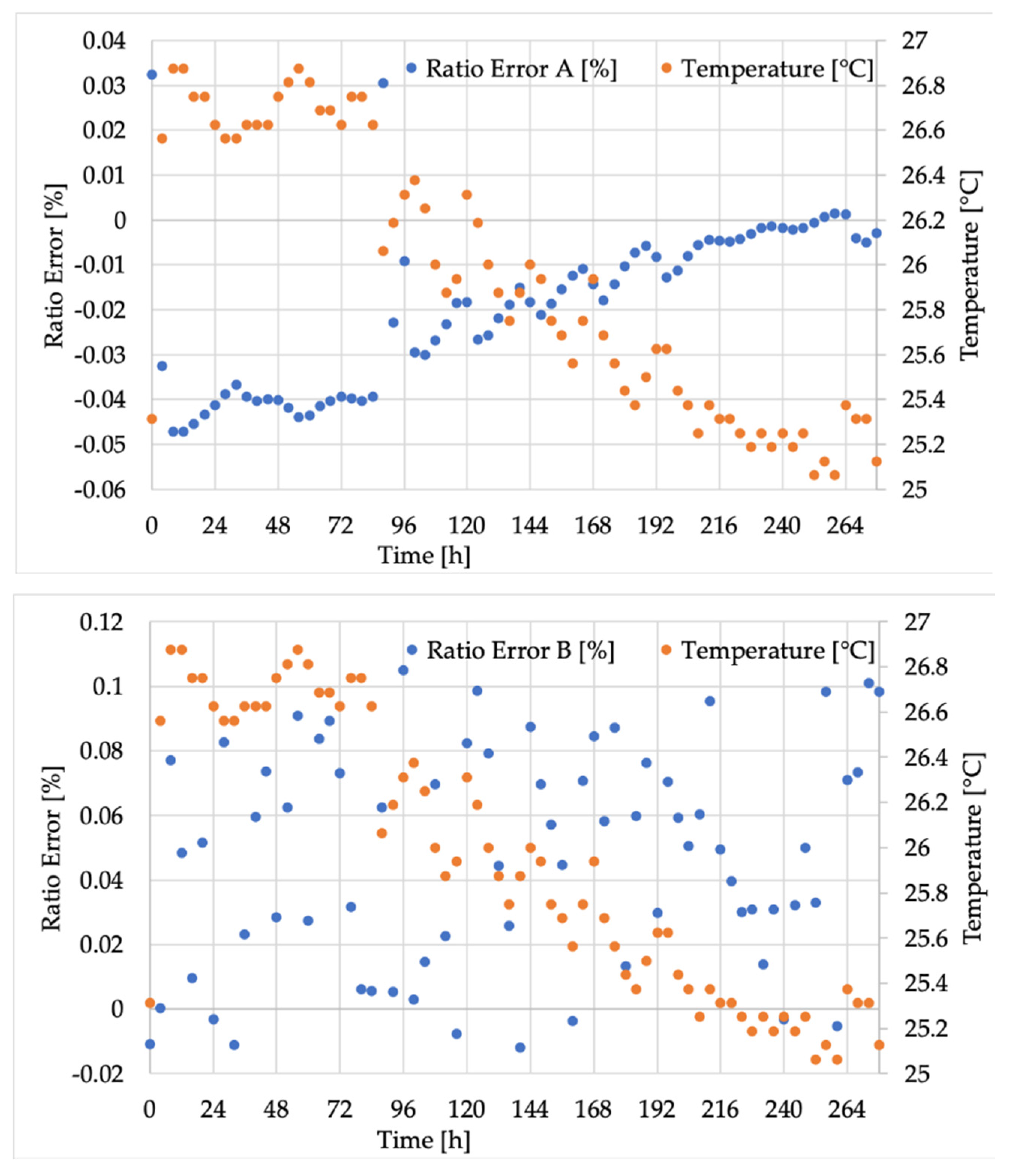
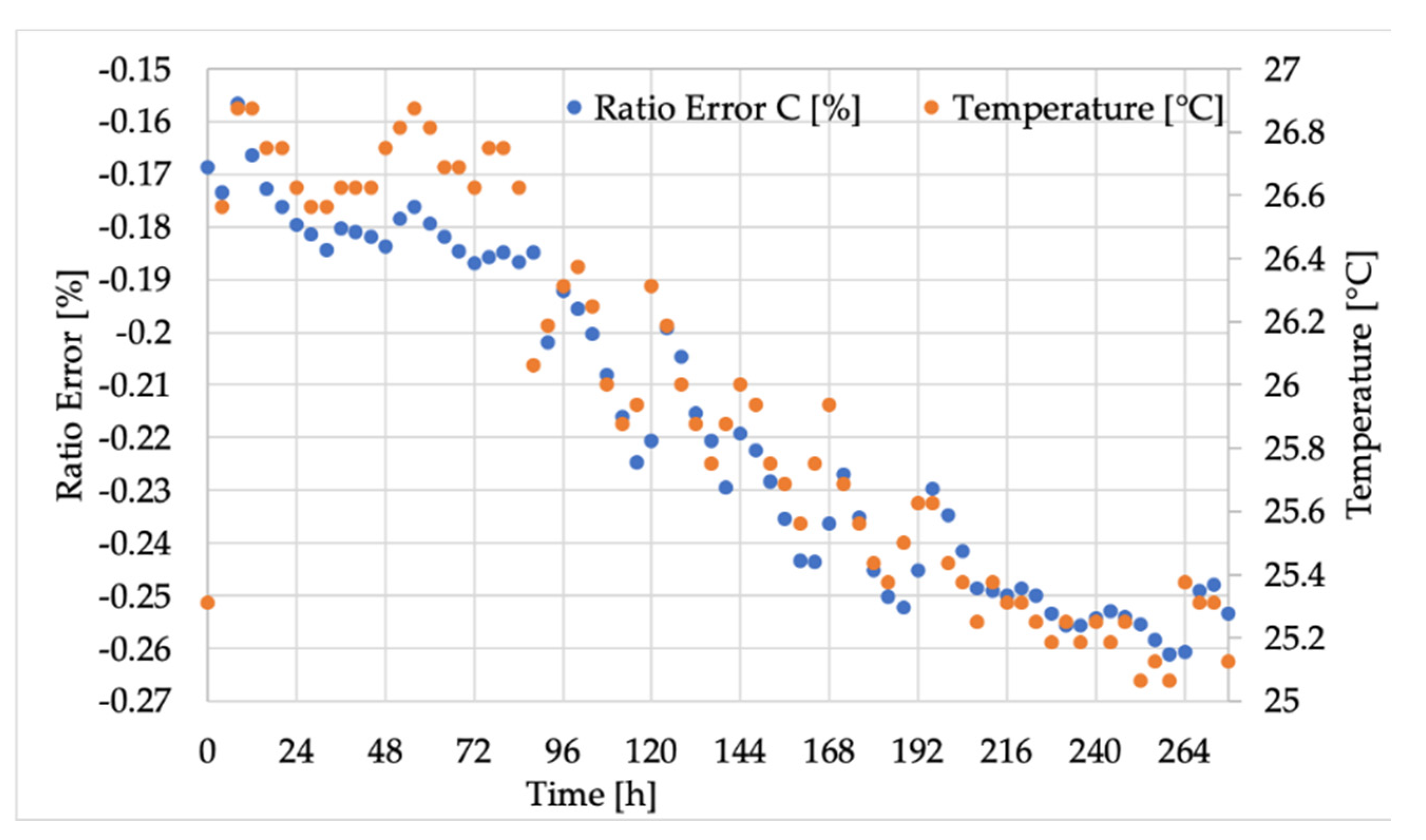
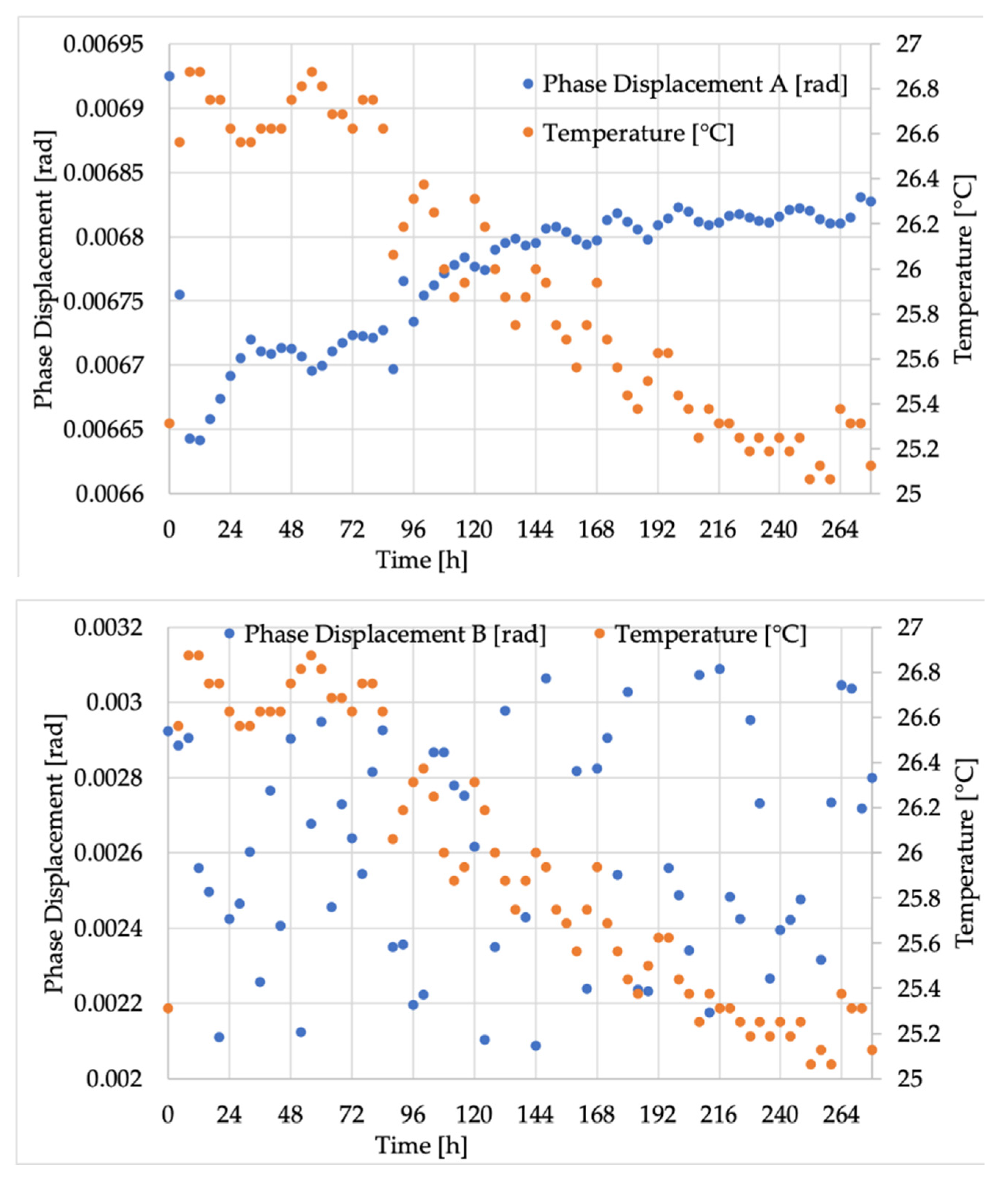
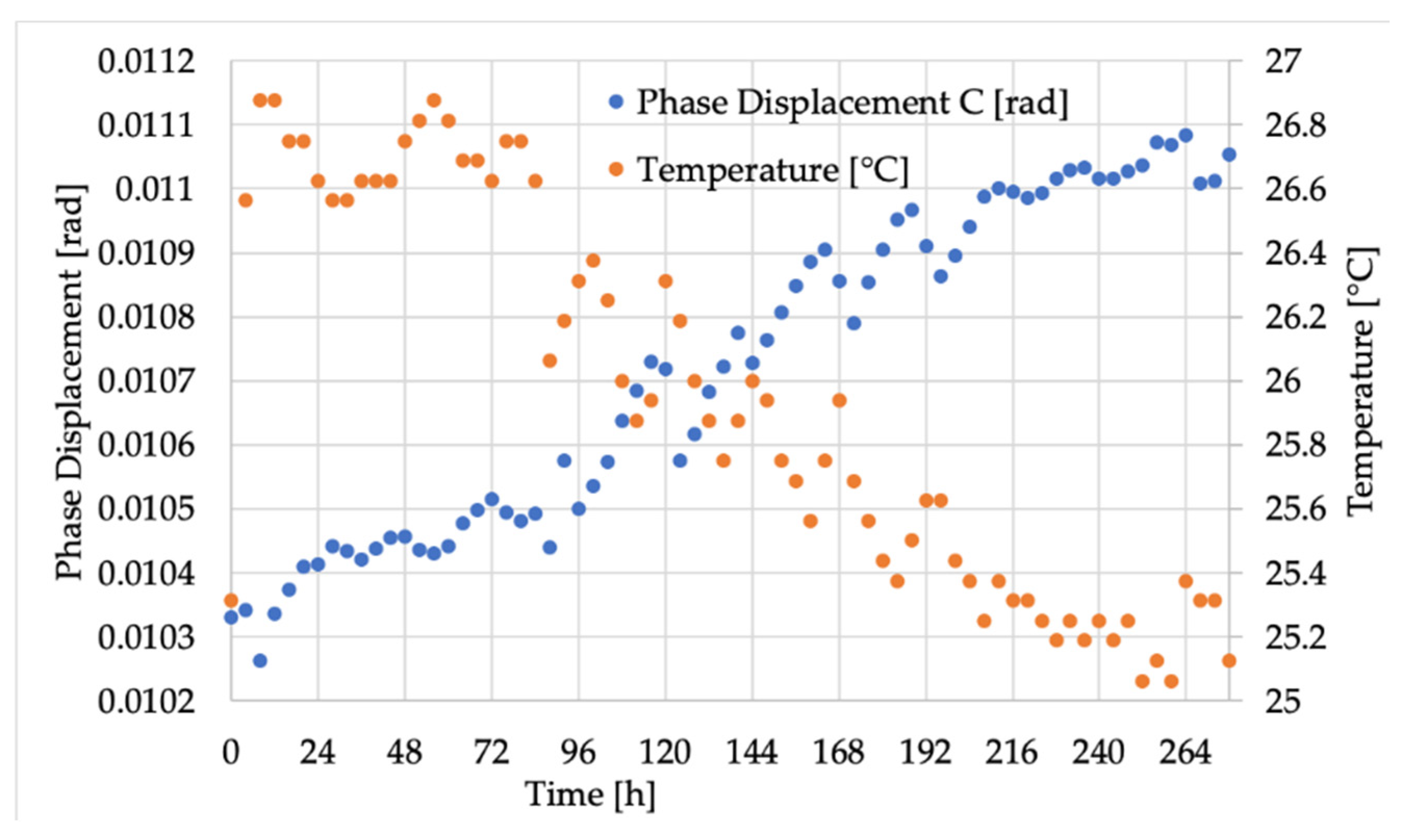

| LPVT | Type | AC | ||
|---|---|---|---|---|
| A | LPVT—Resistive | 0.5 | ||
| B | VT—Inductive | 133 | 0.5 | |
| C | LPVT—Capacitive | 2.27 | 0.5 |
| Feature–Value | |||
|---|---|---|---|
| Resolution | 12 bits | Accuracy | ±1 °C |
| Input Voltage | 3 V to 5.5 V | Update Rate | 80 ms |
| Temperature Range | −55 to 125 °C | ||
| ε [%] | Δφ [rad] | |||||
|---|---|---|---|---|---|---|
| min | max | dε | min | max | dΔφ | |
| A | −0.0471369 | 0.0323216 | 0.0794585 | 0.006641747 | 0.006925065 | 0.000283318 |
| B | −0.0119 | 0.1051 | 0.1170 | 0.0018892 | 0.0030884 | 0.0011992 |
| C | −0.261155 | −0.156676 | 0.104479 | 0.01026314 | 0.01108411 | 0.00082096 |
| ε–T [-] | p-Value | 95% CI min | 95% CI max | Δφ–T [-] | p-Value | 95% CI min | 95% CI max | |
|---|---|---|---|---|---|---|---|---|
| A | −0.873 | <0.0001 | −0.92 | −0.803 | −0.898 | <0.0001 | −0.936 | −0.841 |
| B | −0.011 | 0.930 | −0.245 | −0.225 | 0.021 | 0.864 | −0.215 | −0.255 |
| C | 0.922 | <0.0001 | 0.877 | 0.951 | −0.919 | <0.0001 | −0.949 | −0.873 |
© 2020 by the authors. Licensee MDPI, Basel, Switzerland. This article is an open access article distributed under the terms and conditions of the Creative Commons Attribution (CC BY) license (http://creativecommons.org/licenses/by/4.0/).
Share and Cite
Mingotti, A.; Bartolomei, L.; Peretto, L.; Tinarelli, R. On the Long-Period Accuracy Behavior of Inductive and Low-Power Instrument Transformers. Sensors 2020, 20, 5810. https://doi.org/10.3390/s20205810
Mingotti A, Bartolomei L, Peretto L, Tinarelli R. On the Long-Period Accuracy Behavior of Inductive and Low-Power Instrument Transformers. Sensors. 2020; 20(20):5810. https://doi.org/10.3390/s20205810
Chicago/Turabian StyleMingotti, Alessandro, Lorenzo Bartolomei, Lorenzo Peretto, and Roberto Tinarelli. 2020. "On the Long-Period Accuracy Behavior of Inductive and Low-Power Instrument Transformers" Sensors 20, no. 20: 5810. https://doi.org/10.3390/s20205810
APA StyleMingotti, A., Bartolomei, L., Peretto, L., & Tinarelli, R. (2020). On the Long-Period Accuracy Behavior of Inductive and Low-Power Instrument Transformers. Sensors, 20(20), 5810. https://doi.org/10.3390/s20205810








